Moving from a crib to a toddler bed is a huge milestone for kids and it often comes with sleep challenges. Learn the best ways to handle the transition to a toddler bed for the best sleep for everyone with tips from a certified pediatric sleep consultant.
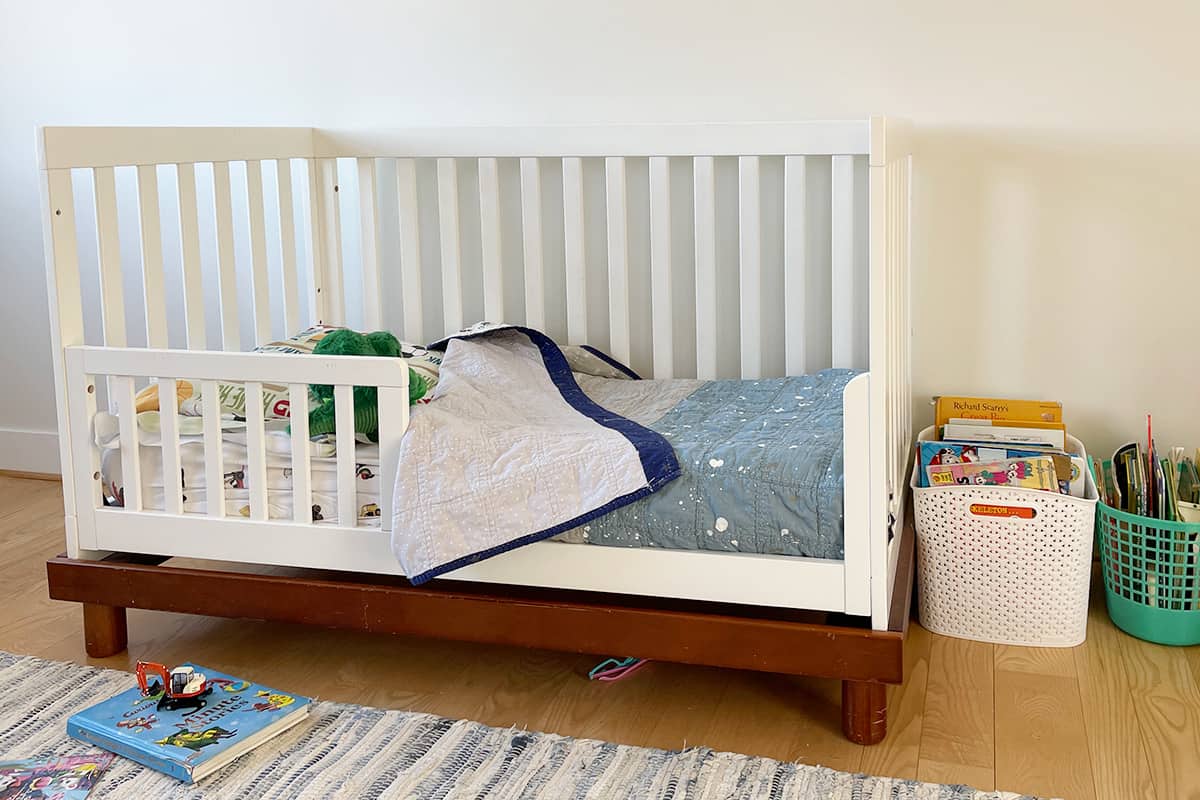
Transition to a Toddler Bed
Moving from a crib to a toddler bed is one of those transitions that comes with so much excitement, but it is often a milestone that can have a giant impact on sleep for the entire family. Whether it’s getting in and out of bed, waking up too early, or another challenge, this guide to the transition is here to help.
As a mom to three kids, I’ve made this transition three times and I learned one key thing along the way—it can be much, much easier if the child is a little bit older than we initially assume is right for this milestone. But since there may be situations where we need the crib for another baby or we need to change the sleeping environment due to a child climbing out of bed, I’ve asked one of my favorite sleep experts to help cover all of the common challenges.
Alicia Birdsong, a certified pediatric sleep consultant and founder of Hush Little Birdie Pediatric Sleep Consulting is here to walk you through how to do it.
Table of Contents
- Transition to a Toddler Bed
- Signs of Readiness
- Best Age to Transition to a Toddler Bed
- How to Transition a Younger Toddler
- How to Help Kids Stay in their Rooms
- How to Handle Nighttime Potty Training
- Example Sleep Rules
- Favorite Okay-to-Wake Clocks
- Baby Gates and Door Locks
- Toddler Beds and Railings
- Toddler Travel Beds
- Toddler Blankets, Sleep Sacks, and Pillows
- Safe Sleeping Reminders
- Frequently Asked Questions
- Best Tips for Success
Your toddler won’t eat? Help is here!
Sign up for our email updates to get tips and ideas sent to your inbox.
Signs of Readiness
“Look for interest in a big kid bed. In addition to this, you can also look for signs of your child wanting autonomy with getting in and out of their bed. It’s important to note that when looking for signs, interest in the child getting in and out of bed shouldn’t be in correlation with trying to stall bedtime. For example, when my oldest was almost 4 years old, she started telling us that she wanted to get in her crib by herself. This was our sign she was ready for a big kid bed, and it wasn’t an attempt to push off bedtime.
Pro Tip: When you transition, if possible opt for a crib-toddler bed conversion kit. That way if the transition doesn’t go as planned, you can easily shift back to the crib if needed.”
Best Age to Transition to a Toddler Bed
“The best age to make the transition is between 3-4 years old. Of course, some parents do have to transition earlier than 3 years of age due to needing the crib for another baby or crib climbing (there are strategies you can use in these situations before shifting right to a toddler bed). I’ve worked with clients in which their 4 year old doesn’t want to transition from their crib, and in those cases we wait until closer to 4.5.
The reason between 3-4 years of age is the best timeframe for the transition from a crib to a toddler bed is because developmentally, children can understand the expectations are to stay in their bed. They also have an easier time with managing the impulse to get out of bed, in comparison to children younger than 3 years of age.
Oftentimes the transition is made too soon. Think of it this way: Just because your child is in the toddler stage, it doesn’t automatically mean they are ready for a toddler bed.
And, if your child is already having sleep challenges in the crib, shifting to a toddler bed will not make things better,” Alicia says.
How to Transition a Younger Toddler
There are of course situations where we need to move a younger toddler from a crib to a toddler bed. If possible, wait until 18 months old. Then involve the child in setting up the new bed, safety-proof the room, remove the majority of the toys to limit possible distractions, consider a baby gate or door lock, and share the family sleep rules consistently so the child learns the expectations.
The transition at this early age may take a little more time, so have patience.
Some additional tips from Alicia:
- “Use a sleep sack to help prevent them from attempting to climb.”
- “Dropping the mattress to lowest height or even the floor is an option, but this won’t work for all cribs. When doing this, we want to make sure there is no gap between the top of the mattress and the frame of the crib. If there are gaps, the mattress can slide around and a child could get stuck in the gaps, which will present as a safety issue.”
- “If there isn’t a safe option to drop the mattress lower, and/or the sleep sack isn’t working, and/or the child exceeds the height or weight limits of the crib, transition to a toddler bed. And safety proof the room, and put a baby gate at the door. Essentially turn the room into a crib.”
- “When it comes to a new baby coming, if the family has the means, I would recommend getting another crib. Another option is to use a pack-n-play in the baby’s room (once they are in their own room) until their oldest is developmentally ready for a toddler bed. We don’t want a situation where parents are navigating newborn sleep and now have sleep challenges with their toddler because they transitioned out of the crib too soon. If the crib has to be used for baby, the best thing to do is what I shared above, safety proof the toddlers room, and baby gate the door.”
How to Help Kids Stay in their Rooms
“The best place to start is to make sure your child’s room is safety proofed, and keep your child’s room free of lots of toys/things they may be tempted to get out of bed and play with,” Alicia says.
So secure dressers and furniture to the walls. Remove any climb-on style toys. Take out favorite things and move them to another room. We typically pared things down to books and a basket of toys the kids could play with if they woke up in the morning and needed to stay put until it was time to come out.
“And prior to making the transition, start talking about the shift to a big kid bed, and put “sleep rules” in place. The sleep rules should be reviewed every night at bedtime during the transition period to help set the expectation,” Alicia says.
How to Handle Nighttime Potty Training
According to Alicia: “I recommend separating the transition to a toddler bed and nighttime potty training. These are two big changes for children, and tackling them at the same time can be overwhelming for them and parents.
Keep in mind, it’s okay to potty train during the day and wait to potty train at night. Even once your little one is in a toddler bed, they may still not be ready to potty train at night. Research shows that some children may not be able to hold their bladder through the night until between 4-5 years of age.”
(Your pediatrician should be able to discuss this in more detail.)
Example Sleep Rules
Here are Alicia’s sample sleep rules, which we used with our second kiddo when we made the transition to a toddler bed at 27 months.
- When it’s time for bed, I will lay down and let my body rest.
- I won’t keep anyone awake.
- I will stay in bed until my light turns green (this refers to an okay to wake clock, which is super helpful for this transition.
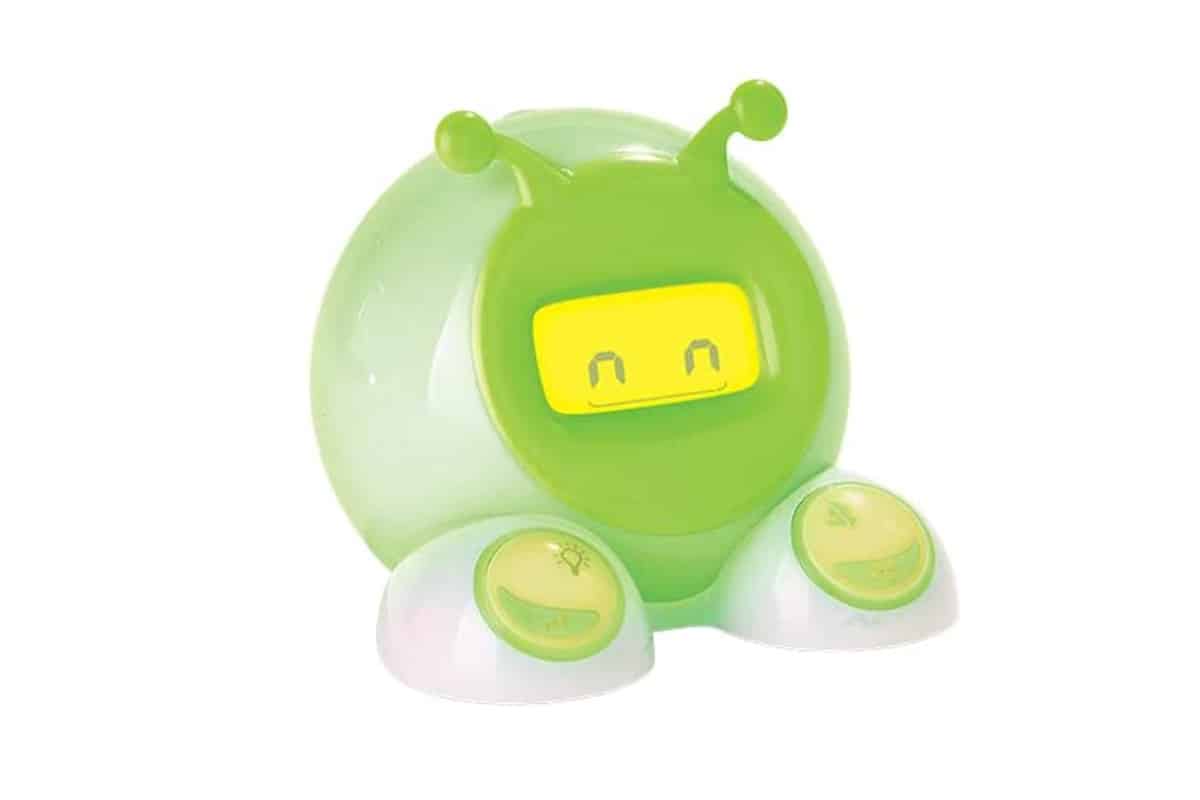
Favorite Okay-to-Wake Clocks
Okay-to-wake clocks are clocks designed for kids that you can set to turn green at a certain time. So basically, it’s a way to visually show kids when it’s okay to be awake or out of their room before they can tell time.
Hatch Rest+ is a favorite okay-to-wake clock. So is this one from Okay to Wake.
Note that this will not work for every child—we personally never had success with it when we tried with two two-year-olds as they viewed the clock simply as a toy. But it is helpful for many families.
It may also help to read the Putting Bungee to Bed book, which has similar sleep rules in it and is a fun story.
“Using a video monitor to keep an eye on your child may also be helpful for you. If they get out of bed, let them know it’s still time for their body to rest, and their light isn’t green yet, then walk them back to bed. Do this every time they get out of bed between bedtime and 6am,” Alicia says.
Baby Gates and Door Locks
“For children who really struggle to stay in bed during this transition, putting a baby gate at the door to help them remember it’s time for their body to rest may be helpful. When using this strategy, we want to leave the gate open initially to give them the opportunity to stay in bed. If they come out of bed, walk them back and remind them that if they choose to get out of bed again, the gate will need to close to help them remember it’s time for rest. You can open the gate in the morning or once they are asleep,” Alicia says.
Some families also choose to use toddler door locks to safely secure the kids in their room and to limit their ability to roam the house at night. Depending on the personality of the child, this can be helpful.
Toddler Beds and Railings
Many cribs come with toddler bed conversion kits that include a front railing. That is a great option. If you need the crib for another baby, look for a toddler bed that is easy for your child to get in and out of, or many families go right to a twin mattress placed on the floor. You can add a bed railing (the kind that slides underneath) and put a soft carpet next to the bed to cushion it as the child learns to sleep in this new environment.
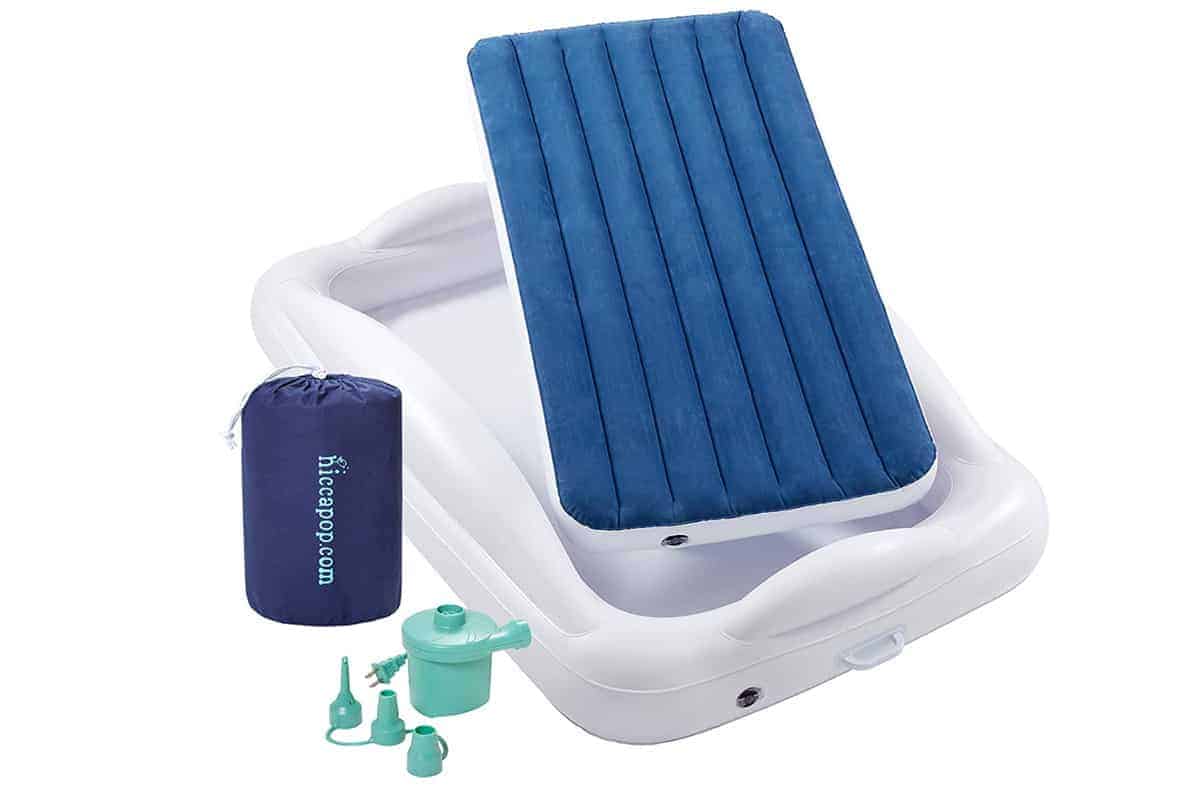
Toddler Travel Beds
Find more information on how to safely set up sleep on the go in my post on toddler travel beds.
Toddler Blankets, Sleep Sacks, and Pillows
The move to a toddler bed often correlates to changing the rest of the sleeping situation. Here are some resources for the rest of the sleep gear you may need:
Toddler Sleep Sacks
You can keep your child in an extra-large sleep sack or wearable toddler blanket if that’s what they’re used to, or look a sleep sack with holes for their feet so they can walk around as needed.
Toddler Blankets
If you move to a twin bed, the Beddy’s zipper comforters are great since they fit around the mattress like a fitted sheet and zip up like a sleeping bag. This ensures that the blanket will stay put while the child sleeps. In a toddler bed, look for a baby-size quilt, which is smaller than a twin.
Toddler Pillows
For safe sleeping, the American Academy of Pediatrics recommends that we avoid pillows and blankets before age two. After that age, look for a pillow that’s flat and firm. You also don’t have to add a pillow if your child seems fine without one.
Safe Sleeping Reminders
For kids under age 1, it is recommended that they be put down to sleep on their backs on a firm, flat surface without pillows, stuffed animals, or blankets. Read the full sleep recommendations here.
After age 1, the American Academy of Pediatrics says it’s okay to introduce a blanket, toys, and a pillow—but many sleep experts caution that it’s safe to wait longer until age 2 due to potential suffocation risk.
We didn’t introduce a pillow or a blanket until at 2.5 and then age 3.5, or at the age that we transitioned to a toddler bed.
Frequently Asked Questions
Alicia Birdsong, pediatric sleep consultant, recommends making the transition between the ages of 3 and 4 since kids are better able to understand expectations and control impulses at that age.
Involve them in setting up the new bed, share the family’s sleep rules and expectations, baby proof the room, make a plan to consistently take the child back to bed if they get out, and know that the transition may take a little time to work.
Experts recommend not doing two big transitions at the same time, so you may want to do it before the baby comes if you plan to use the crib right away. Or if baby will sleep elsewhere for a few months, keep the older child in the crib until it’s time for that transition. Make a big deal out of the new bed, involve them in changing the room, and know that there may be feelings about the baby sleeping in their crib.
Best Tips for Success
- Wait until the child shows interest in a toddler bed and is, ideally between 3 and 4 years old.
- If you need the crib for another baby at an earlier age or the child is climbing out of their crib, that is of course fine. The transition may take a little longer to stick. Consistency is key.
- Baby proof the room so that everything is secured. Avoid pillows, blankets, and stuffed animals in the bed until at least age 1, and perferrably age 2.
- Stick to a bedtime routine and share the family sleep rules regularly.
- If the child gets out of bed, walk them back to it as many times as is needed.
- Consider having a dedicated basket of toys for them to play with in the morning if they wake up before it’s time to leave the room.
- An Okay-to-Wake Clock may help kids visually see when it’s okay to be awake.
Thank you to Alicia Birdsong, certified pediatric sleep consultant and founder of Hush Little Birdie Pediatric Sleep Consulting, for helping provide tips throughout this post.
Related Posts
I’d love to hear your feedback on this post, so please comment below to share.

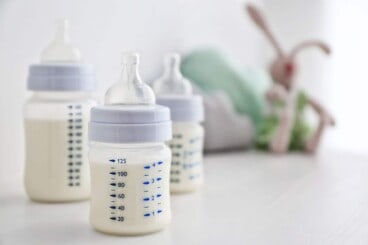
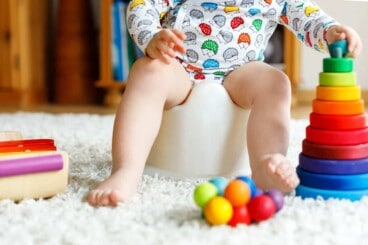



















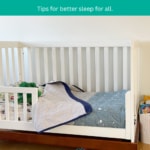
Hello! I have a question about height and weight restrictions. My 19-month-old is 34.5 inches tall, and both his crib and his pack and play come with height restrictions of 35 inches. He is not climbing out and seems to love his crib, but I have felt pressured to transition his bed to the toddler stage soon. (His crib is convertible, so we would just take one side off and replace it with a bumper to make it a toddler bed).
what advice do you have for parents of kids on the taller side? He will be able to physically fit in his crib for a long time to come, but the pack and play might become too small for him to lay down much sooner. Is it too much for me to ask him to sleep on an inflatable toddler bed when we are traveling, and remain in his crib at home? If he’s not climbing, can I ignore those height restrictions on his crib?
thank you so much!!
From what I have seen online, it is okay to continue to use the crib as long as they aren’t climbing out but I would verify that with your pediatrician. With traveling, many kids that age sleep on little cots at daycare and cribs at home, so that seems like it could be an option that would make sense. And since travel comes with a whole host of other circumstances, I bet the kiddo would understand that this is how we do it when we’re away from home while it stays the same at home (if that makes sense).
We have an almost 3 year old who has been sleeping in a queen sized bed for almost a year now. The past 4 months or so, we found that she has multiple night wakings and will wander to our room and attempt to crawl in our bed (we have never coslept). We bought a monkey latch for the door but found that she will just cry in the middle of the night because she can’t open the door. Any suggestions on frequent night wakings?
Hi- I’ll ask Alicia and see if she can share some advice!
Just wanted to share that we have recently transitioned our nearly 3 year old to a big bed. The main reason was that he was waking so much overnight and rising at 4.30. We tried all the standard advice, but our wilful toddler persisted despite his (and our) exhaustion.
We think he was much more conscious of being alone and the dark, feeling scared (despite a night light).
The big boy bed has made a huge difference! He now only wakes once to wee and we can lay with him to settle him to sleep. I think the autonomy and being able to see the whole room, has made him feel more comfortable.
So, maybe a sign to look for is also, a wakeful toddler and sleep difficulties!
Thanks for adding that!